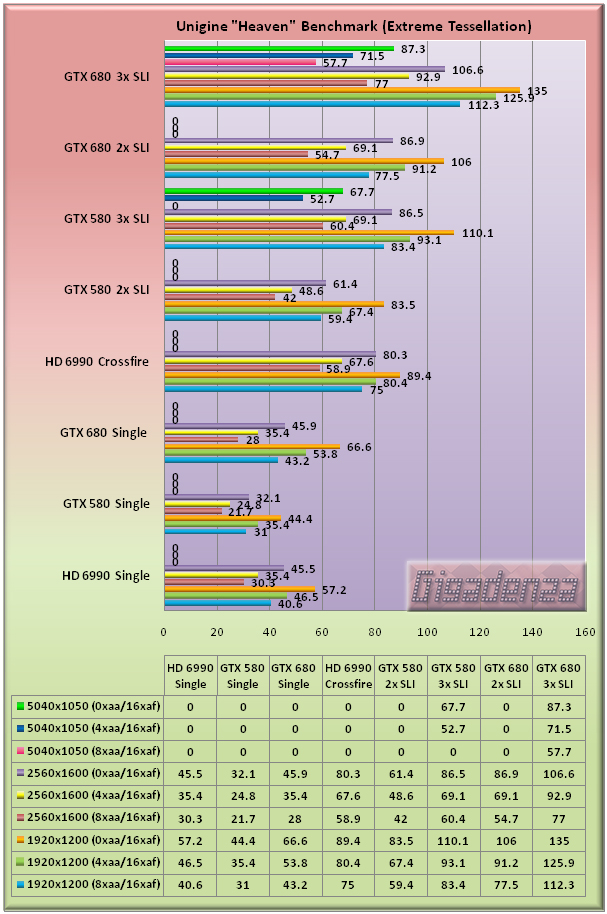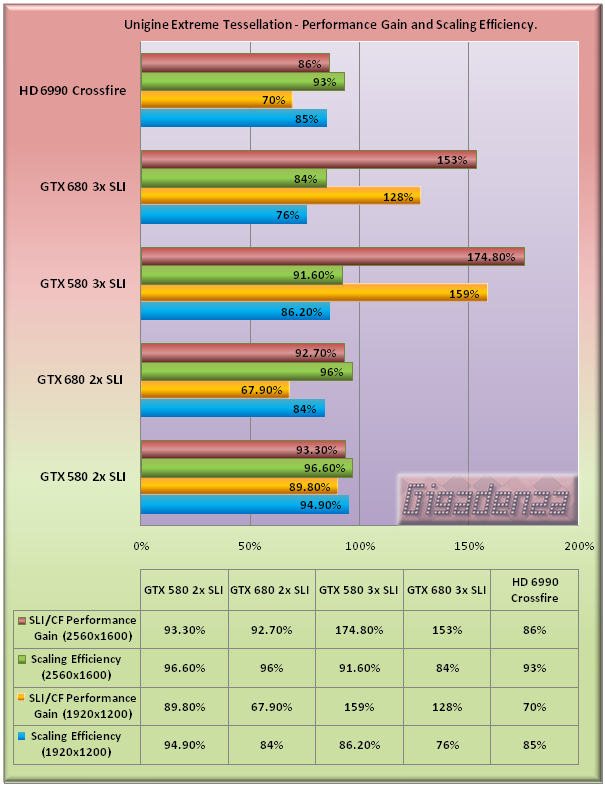The “Kepler” Rides Out – The Benchmarks.

Enabling extreme tessellation hands the advantage to Nvidia. A single 680 now has a 6990 covered in four out of the six tests while the gap between the 680 and its elder remains broadly the same as with normal tessellation. The 6990s in crossfire lose a little more ground to the 680s in SLI but maintain a lead over a pair of 580s. Two 680s still can’t quite catch three 580s, again indicating that both cards handle tessellation with equal efficiency.
In the three way SLI tests, the 580s again had issues completing the benchmark at 5760×1200 with 8x AA applied while the 680s, by virtue if an additional 512mb of memory per card were able sustain a frame rate of almost 60fps.

As one would expect, the performance increase generated by a second and third 580/680 is greater than with normal tessellation. The 6990 also shows improvements at both resolutions.
Conclusion.
Our story has come a long way since the beginning of March 2012, when rabble rousing rumors sufraced pertaining to the Kepler’s imimant release. Amongst these was one particularlly bold claim that suggested its power to be the equal of three GTX 580s. This has turned out not to be true, not even close. The group of benchmarks featured here might not have included such recent titles as Battlefield 3, Dirt 3, Metro 2033 and others but based on the results obtained, it couldn’t even be argued that one 680 is able to convincingly trade blows with two 580s, let alone three.
Hype surrounding AMD’s and Nvidia’s eternal quest for speed is certainly nothing new but when its so sensational and fails to take wing, it allows hordes of detractors to react with a torrent of negativity, invariably drawing much attention away from improvements and features that might have otherwise commanded universal praise.
The GTX 680 really is an excellent video card and here a some reasons why:
Its performance is significatly higher than the abdocating 580, rarely below 30% and frequently approaching 50%.
At stock speeds, its temperature did not exceed 88 degrees under load, even in three way SLI in a closed case and with its fan speed left on the default “automatic” profile. This was at least 5 degrees cooler per card than the 580.
By virtue of the above, it is noticeably quieter and quite possibly the quietest card of its generation compared to any that offer an equivalent level of performance.
It was regularly able to match and in some cases surpass the raw pace of AMD’s dual GPU 6990, a card which at the time writing was considered by many to be the fastest money could buy and consumes an average of around 150 watts more.
For those who have already opted for a 7970 or who don’t mind a slightly higher electricity bill, it is unlikely to be a justifiable purchase but owners of 480s and 580s seeking a healthy performance bonus could do a lot worse than find a new home for their old cards and use the proceeds to re-invest! If money is no object, a couple of Keplers will have nothing to fear in the current gaming climate and three of our eco-friendly pixel crunchers will see you burn through any game at any resolution with all the candy your eyes can guzzle as well as ensure that your family of 120hz 3d monitors gets a comprehensive workout.




